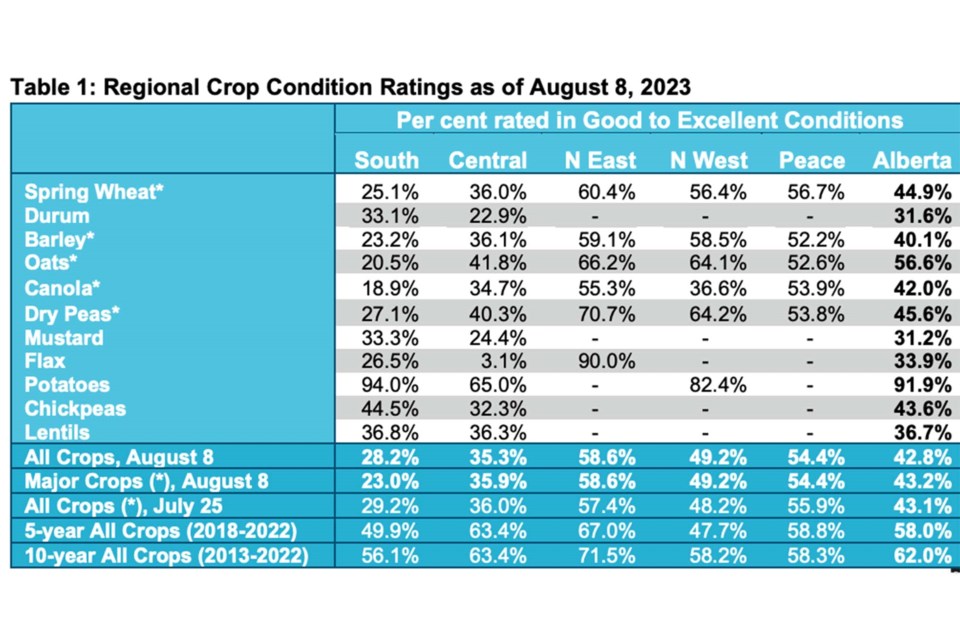ALBERTA - Crop conditions in regions in South and Central Alberta remained poor at the beginning of August.
The Aug. 8 Alberta Crop Report shows overall crop conditions below the five-year average, with the South and Central regions rated poorest.
The good-to-excellent rating on crop conditions for Alberta for all crops is 42.8 per cent, compared to the five-year rating of 58 per cent.
The crop conditions for all crops in the South region which includes Strathmore, Lethbridge, Medicine Hat, and Foremost are rated the lowest at 28.2 per cent of all crops rated good to excellent.
The Central region, which includes Rimbey, Airdrie, Coronation, and Oyen, was rated second lowest with 35.3 per cent of crops rated in the good-to-excellent category.
The North East region, which includes Smoky Lake, Vermilion, Camrose, and Provost, had the highest-rated crop conditions, with 58.6 per cent of all crops rated in the good-to-excellent category.
The Peace region, which includes Fairview, Falher, Grande Prairie, and Valleyview, had 54.4 per cent of all crops rated in the good-to-excellent category, while the North West Region, including Barrhead, Edmonton, Leduc, Drayton Valley, and Athabasca, had 49.2 per cent of all crops rated good to excellent.
Dryland yield estimates are below the five-year yield index.
“Provincially, the estimated dryland five-year yield index of major crops is 84.7, indicating that provincial yields are estimated at 15.3 per cent below the five-year averages,” the report says.
Data from the report showed the North West region had the highest yield estimates at 7.1 per cent about the five year averages, the North east region had 6.7 per cent below the five-year average estimates, and the Peace region had 9.6 per cent below five-year estimates.
“The five-year yield index estimates are reported the lowest in the South and Central where they are 33.3 and 26.6 per cent below the five-year average, respectively,” the report reads.
Winter wheat, oats, and mixed grains had the strongest five-year yield estimates, while fall rye, spring triticale, and chickpeas were noted as the poorest.
Overall, provincial surface soil conditions have declined five per cent since the last report with the average ratings hovering around 29 per cent in the good, fair, and poor categories.
The South region had the driest soil conditions with 64.5 per cent of the surface soil moisture rated as poor, 28.3 per cent rated as fair, and 7.2 per cent rated good.
The Central region also had poor surface soil moisture rating with 25.8 per cent rated poor, 44.5 per cent rated fair, 26.8 per cent rated good, and 2.9 per cent rated excellent.
The North East region was reported with 6.6 per cent of sub surface soil moisture ratings being poor, 29.9 per cent rated fair, 52.9 per cent rated good, and 10.1 per cent rated excellent.
Subsurface soil moisture ratings in the North West were rated more favourable; however, 10. 3 per cent of the area was rated as having excessive moisture. None of the North West region had poor-rated surface moisture conditions, 13.7 per cent was rated as fair, 50.1 per cent of the area was rated as good, and 26 per cent of the sub surface soil conditions in the area were rated as excellent.
Data from the report showed subsurface soil conditions in the Peace region were rated 6.4 per cent poor, 19.5 per cent fair, 37.1 per cent good, and 36.1 per cent excellent.
Pasture and tame high growing conditions continue to decrease, the report said.
“Both fell another two per cent (rated good to excellent) since the last report. Provincially, pasture growth conditions are rated 36 per cent poor, 35 per cent fair, 28 per cent good, and one per cent excellent. Tame hay is rated 28 per cent poor, 37 per cent fair, 33 per cent good, and 3 per cent excellent,” said the report.
Dryland hay yield in the province is also down from the five-year average.
“The highest yield estimates were from the Peace (1.1 tons per acre) and the lowest was in the South (0.8 tons per acre),” the report said.
The full report can be found at https://open.alberta.ca/dataset/92dc0d33-edc7-47ec-be8d-a334ea145ded/resource/df350be0-0131-4d88-91d5-3394dbf26b3f/download/agi-itrb-alberta-crop-report-2023-08-08.pdf




